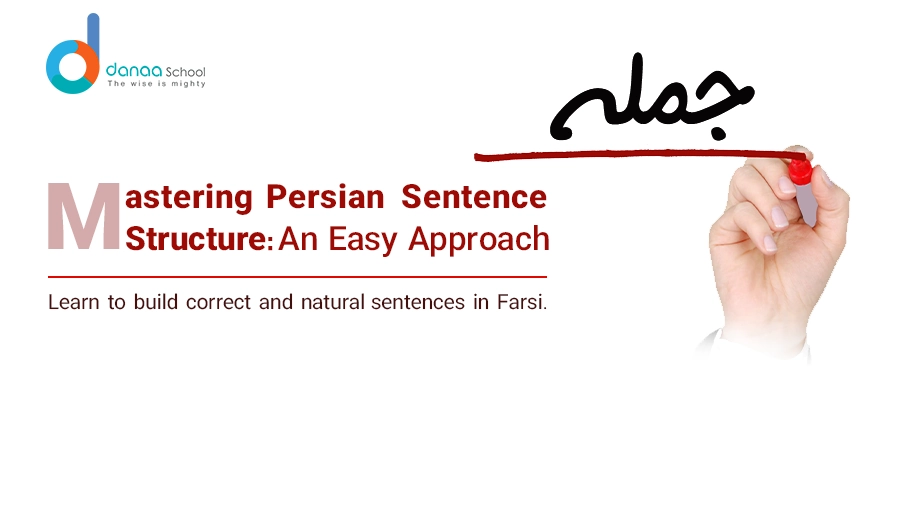Persian, also known as Farsi, is a captivating language with a unique sentence structure that differs significantly from English. By grasping the rules of Persian grammar and syntax, learners can construct meaningful sentences and communicate effectively. This guide offers a practical, step-by-step approach to understanding Persian sentence structure, including tips on Persian verbs, prepositions, and auxiliary verbs.
What Is Persian Sentence Structure?
In Persian, sentences typically follow a Subject-Object-Verb (SOV) structure. This contrasts with English, where the standard order is Subject-Verb-Object (SVO). For instance:
-
- English (SVO): I read a book.
-
- Persian (SOV): من کتاب میخوانم
(man ketâb mikhanam – literally: I book read).
- Persian (SOV): من کتاب میخوانم
Understanding this core difference is key to mastering Persian sentence construction.
How to Say ‘Sentence’ in Farsi
The Persian word for “sentence” is جمله (jomle). To discuss sentence structure in Farsi, you can say:
-
- ساختار جمله در فارسی (sâkhtâr jomle dar Fârsi) – “Sentence structure in Persian.”
Simple Sentences in Persian
Simple sentences in Persian consist of a subject, an object, and a verb. For example:
-
- من کتاب میخوانم (man ketâb mikhanam) – “I read a book.”
Here’s the breakdown:
-
- من (man) – Subject: “I”
-
- کتاب (ketâb) – Object: “book”
-
- میخوانم (mikhanam) – Verb: “read”
English Sentence Structure vs. Persian Sentence Structure
The difference between English and Persian sentence structure lies in the word order. In English, verbs often appear directly after the subject. However, in Persian, the verb typically comes at the end of the sentence. For example:
-
- English: She is writing a letter.
-
- Persian: او نامه مینویسد
(ou nâme minevisad – literally: “She letter writes”).
- Persian: او نامه مینویسد
Persian Verbs and Their Placement
Verbs are the backbone of any sentence. In Persian:
-
- Main verbs are often placed at the end of a sentence.
-
- Auxiliary verbs like “to be” or “to have” may precede the main verb but still conform to the SOV pattern.
Example with Auxiliary Verbs:
-
- من کتاب خواندهام (man ketâb khândeh-am) – “I have read the book.”
Understanding the Persian Alphabet
To construct sentences in Persian, it is crucial to familiarize yourself with the Persian alphabet, which consists of 32 letters. It is written from right to left, and many letters change their shape depending on their position in a word.
Find Your Ideal Teacher
At Danaa School, you can choose your Farsi tutor from a selection of qualified and experienced teachers. Begin an exceptional journey into the world of Persian language!

Persian Prepositions in Sentences
Prepositions in Persian, like in English, connect nouns, pronouns, and phrases to other words. Common prepositions include:
- در (dar) – “in”
- روی (ruy) – “on”
- با (bâ) – “with”
Example:
- کتاب روی میز است (ketâb ruye miz ast) – “The book is on the table.”
Here, روی (ruye) indicates the location of the book.
Constructing Meaningful Sentences in Persian
Constructing sentences in Persian involves understanding the interplay between subjects, objects, and verbs. Persian sentences rely heavily on context and often omit pronouns when implied by the verb conjugation.
Example:
- میخوانم (mikhanam) – “I read.”
The subject من (man) is understood from the verb conjugation.
Word Order in Persian
Persian sentences adhere strictly to the SOV order. Adjectives precede the nouns they describe, and possessive structures are formed using از (az, meaning “of”).
Example of Adjective Placement:
- یک کتاب جدید (yek ketâb jadid) – “A new book.”
Prepositional Phrases in Persian
Prepositional phrases are vital in Persian sentence structure, often clarifying location, time, or manner.
Example:
- من در خانه هستم (man dar khâne hastam) – “I am at home.”
Subject, Object, and Verb in Persian Sentences
In Persian, the subject, object, and verb each serve distinct roles in a sentence. The subject initiates the action, the object receives it, and the verb concludes it.
Example:
- من به مدرسه میروم (man be madreseh miravam) – “I go to school.
Nouns and Pronouns in Persian
Persian nouns do not have gender, making the language simpler in this regard than many others. Pronouns, however, vary depending on the subject.
Personal Pronouns in Persian:
- من (man) – I
- تو (to) – You
- او (ou) – He/She/It
Auxiliary Verbs in Persian
Auxiliary verbs are commonly used in Persian to form compound tenses. The most frequent auxiliary verbs include بودن (boodan, “to be”) and داشتن (dashtan, “to have”).
Example:
- من داشتم مینوشتم (man dashtam mineveshtam) – “I was writing.”
The Role of Tenses in Persian Grammar
Persian verbs are conjugated to express various tenses, including the present, past, and future.
Simple Past Tense Example:
- من کتاب خواندم (man ketâb khândam) – “I read the book.”
Finally, the Verb: Placing It Right
The final position of the verb in Persian sentences gives the language its distinct rhythm. Even in compound sentences, the main verb holds its position at the end.
Example:
- او میخواست که به خانه برود (ou mikhâst ke be khâne beravad) – “He wanted to go home.”
Learning Persian Grammar Through Practice
Regular practice is essential to mastering Persian. Focus on constructing sentences, identifying patterns, and using tools like flashcards or language apps.
Tips to Learn Persian with Ease
- Immerse Yourself: Watch Persian movies or listen to Persian music.
- Practice Daily: Dedicate time to writing and speaking in Persian.
- Use Resources: Enroll in programs like Learn Farsi with Danaa School for structured lessons.
FAQs
What is the basic word order in Persian?
Persian follows a Subject-Object-Verb (SOV) order.
How are verbs conjugated in Persian?
Verbs in Persian are conjugated based on tense, subject, and formality.
What is the Persian alphabet?
The Persian alphabet is a 32-letter script written from right to left, derived from Arabic.
Are there gendered nouns in Persian?
No, Persian nouns are not gendered.
How do you say "I am reading" in Persian?
“I am reading” is من میخوانم (man mikhanam).
What are common Persian prepositions?
Common prepositions include در (dar, “in”), با (bâ, “with”), and روی (ruy, “on”).
Conclusion
Understanding Persian sentence structure is the first step toward fluency. By focusing on the SOV order, mastering verb placement, and familiarizing yourself with Persian grammar, you can confidently construct sentences and engage in meaningful communication. With dedication and practice, learning Persian will be achievable and deeply rewarding. Sign up now.
Want to Learn Farsi at Danaa School?
Here are the best resources for you!







